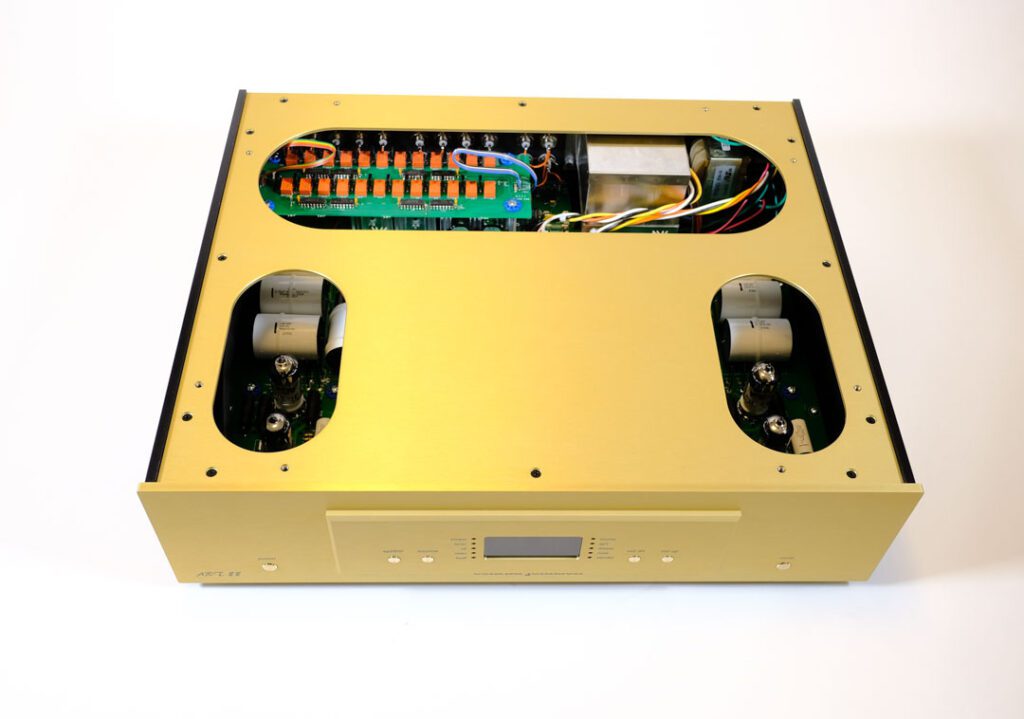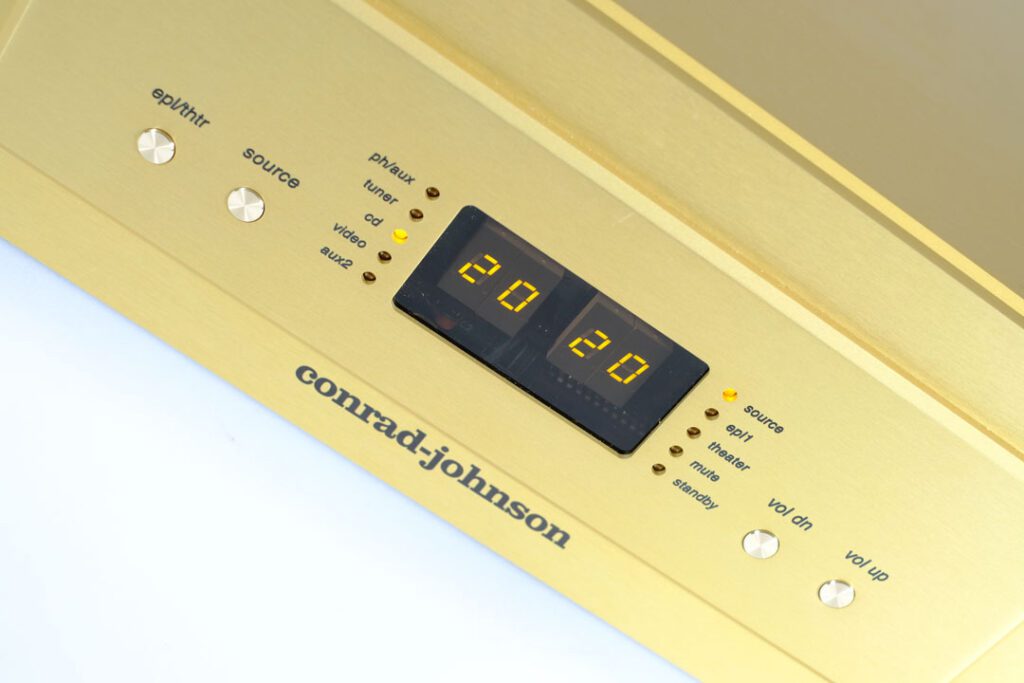
TLAs (Three Letter Acronyms) abound in audio, and conrad-johnson’s evolving line of TNPs (Top-Notch Preamplifiers) is no exception. Starting with the ART (Anniversary Reference Triode) preamplifier of 1996, the company’s top preamplifiers began to use names like ACT (Anniversary Composite Triode) and GAT (Great Anniversary Triode… c-j does a lot of anniversary celebrating), and now we are back to ART again, this time the ART88. And, no… I have no idea why there is an ‘88’ in the name; it’s presumably to differentiate it from its 1996 predecessor and the ART27A, ART108A, ART150 and ART300 power amps.
The first thing that matters about the ART88 preamplifier is the return to pure valve audio circuits and all the wonderful roots of the long conrad-johnson design history. A simple but ingenious circuit comprising a main input double-triode followed by another one of the same kind serving as a cathode follower kept the impedance so low that long interconnects to the power amplifier could be used without any detrimental high-frequency roll-off. For a while, conrad-johnson experimented with a discrete device (FET) as a cathode follower (instead) of a valve. And, it must be said, with some success… the GAT in all its guises remains one of the best preamps ever made, but it is good to see the return of a fine tradition in the ART88.
Solid cover
Taking a very solid top cover off reveals a new and far more elegant and substantial approach to the layout and execution of this audio engineering marvel. I don’t think I have ever seen a more tidily and precisely manufactured conrad-johnson product! Perfect symmetry and precision in laying down every single passive and active component, carefully dressed and curved internal wiring, cleverly suspended sub-assembly boards holding components most susceptible to microphony (valves) and mechanical resonances and vibrations (volume attenuator and input/output switching relays)… it all adds up to very high levels of craftsmanship and painstaking attention to detail.

The symmetry extends to the circuit itself. This is a dual-mono preamp, with the two channels sharing only a power transformer, the chassis and the logic control. Each channel comprises a single triode gain stage using a PCC88 double triode tube coupled to the output through a buffer stage, which includes a second PCC88 for low output impedance.
As with every contemporary conrad-johnson product, fully regulated power supplies for every stage of the audio circuits are all present and correct, developed and expanded more than we have seen ever before in a c-j preamplifier. An ample reserve of capacitive energy is stored in proprietary CJD polypropylene capacitors, followed by the highly prized CJD Teflon (PTFE) capacitors, and bypassed by smaller values of the same wherever beneficial. The audio circuits use exclusively Teflon capacitors. Its ‘no feedback, no electrolytics’ maxim holds as strong today as ever. And as ever, Dow Corning and custom-made Vishay metal foil resistors are used extensively, while the relays used in input switching and gain are also made specifically for conrad-johnson.
Radiating finesse
All digital computing circuits for switching and volume control have their power supplies, with a smaller, dedicated mains transformer to ensure total isolation between the logic circuits and the audio signal path. For the first time, rhodium-plated Cardas Audio RCA sockets are implemented for the entire population of the back panel. The solid and elegant c-j remote control handset is present as standard, too. I have to say the ART88 radiates true elegance and finesse alongside the usual authority and purposefulness that has been a trademark of c-j products for almost 50 years.

The choice of PCC88 is interesting in its way and for a straightforward reason. Unlike all the variants from the ECC family (81,82,83 and 88) – designed for use either in audio, bench testing or military equipment (and manufactured to a different degree of mechanical resilience accordingly), PCC valves (including the 88) were designed for use in TV sets based around a cathode-ray tube. This imposed a different set of criteria and parameters to be met for that application. The PCC88 is inherently somewhat ‘noisier’ than a good ECC88 and slightly more sensitive to mechanical excitations. Notwithstanding all this, the PCC88 has been used by several reputable high-end audio designers in the 70s and 80s with excellent results.
Higher gain
Typically, conrad-johnson line preamplifiers have a fairly high gain compared to peers of similar stature and aspiration. If you have a power amplifier with a sensitive input, 25dB of gain rushing into it may reduce the granularity of your volume control, especially at the low end. However, the ART88 worked well with a sufficient variety of valve and solid-state power amplifiers for this review without any issues or mismatches. The output impedance is an exemplary low 190 Ohms, while a healthy maximum output of 10V RMS ensures more than enough signal reaches almost any competently designed power amplifier of modern times, valve or not.

High-end audio enthusiasts would not be just that unless they were restless souls in many ways. Knowing the fact all c-j line stage flagships since the legendary Premier 7, happened to use ECC88 double triodes (aka 6922) – even the model called ACT2 used a rare, Russian valve called 6N30P that was not far off in its spec and behaviour – an unavoidable email to Jeff Fischel followed with a “What if…could it be done?” question brought a swift reply to feel comfortable to try out “your favourite ECC88/6922 as a direct replacement and hear for yourself”.
Bearing that the best ECC88/6922s are made in Russia, that’s easier said than done. As a result of the Ukrainian conflict and the subsequent outlawing of Russian goods, they have increased in price drastically. Thankfully, the UK distributor of conrad-johnson had a small number of EH (Electro Harmonix) 6922 GOLD valves in their vault to be tried. EH valves are known as very consistent and good sounding, plus c-j used the same brand for several years in their preamplifiers and the input stages of power amplifiers with enviable results.
A selection of interesting tubes
The conrad-johnson ART88 comes from the factory with a quartet of selected NOS PCC88 double triode valves. Their contribution to the sonics experienced and described in the main body of this review is beyond any question. But, the circuit itself has proven itself many times when ECC88 double triodes were used. And with great results, too. And not just any 88s, the Russian EH6922s. PCC88 and ECC88 operate under different heater (filament) voltages, and that Jeff Fischel encouraged straight swaps could be another testament to his engineering craft. So, we did as we were told we could. And…?
…well, sometimes decades of experience do not help much. Playing the same music with both ‘flavours’ of ’88s was the proof of the pudding. And the pudding was that using the ECC88/EH6922s in the ART88 pushed this traditional high-end audio design masterpiece to another level and into another dimension of reproduced sound!
Subjectively, the ECC88s delivered less gain and certainly noticeably more ‘black within silences’. The EH6922 gave the ART88 much more of the traditional, ethereal midrange musicality combined with a far more developed soundstage in every direction. The transient response felt faster and more solid with low frequencies even more extended while still under total control and body. In short, a beautiful conrad-johnson transposed itself into an even more beautiful conrad-johnson!
The ‘less gain’ aspect is important; amplifiers have their own optimum gain structure. With the PCC88s in place, it’s almost too much of a good thing, and you’ll need a safe-cracker’s touch to set the right gain setting, especially at low levels. Meanwhile, with a good set of ECC88s on board, there’s more nuance to be had at lower listening levels.
If you ever own an ART88 and can source good ECC88/6922 valves, you owe yourself this at any cost. It will be a small price to elevate the ART88 even more into the zone of unassailability.
Tube Rolling? Maybe not
However, I don’t want this review to be dominated by ‘tube rolling’, and conrad-johnson’s pragmatic solution is echoed by audio and guitar amp makers worldwide. It’s a sign of the quality of this preamplifier circuit that it sounds exceptionally good with PCC88s. It’s truly whisper quiet at any given volume level, albeit with the slight sound of the relays as you raise and lower it. The sound is very well-balanced, too; not ‘poised’ as that implies some fragility to the sound. The ART88 has ‘music’ written into its DNA.
Think of this preamp as a GAT that has gone back to its roots; a preamplifier with all the leading-edge detail and precision demanded of a top-class 21st Century preamplifier coupled with that sense of refinement and effortless charm that was the stuff of the best preamps of 40 or so years ago. Yet, in so doing, the ART88 is neither a rose-tinted throwback nor a middling compromise; it carves out its own space in the audio canon.

Although I don’t mention it as often as I used to, ‘Memphis Soul Stew’ by King Curtis [King Curtis Live At Fillmore West, ATCO] perfectly highlights this double-whammy of good. The slow build of the recording, introducing one genius musician after another (a lineup that includes Cornell Dupree, Jerry Hemmott, Bernard Purdie and Billy Preston on organ can’t be all bad), coupled with the final few minutes where the entire band is riffing like crazy. The modern, leading-edge detail delivery means that when Cornell Dupree starts playing those infinitely clever Telecaster rhythm riffs, they are easily delineated and sound live as if the band is in the room with you. Meanwhile, the effortless charm part is when it gets a bit crazy and raucous toward the end, you can still listen into the mix and ‘raucous’ never means ‘brash’ or ‘unlistenable’.
The more I moved through my records – both the ones I use for assessing audio equipment and the ones I still listen to for musical enjoyment – the ART88 managed to combine the best of all possible preamp worlds, combining that rare insight into the music with dynamism, energy and a whole lot of entertainment. That puts the ART88 among the best preamps ever, including the GAT Series 2 it de-throned.
Realistic and Restive
It’s worth mentioning what happens when you move to ECC88s here, and that ‘well-balanced’ sound takes on a new sense of purpose and performance. Music is more realistic, and, most importantly, more restive than usual. It’s easy to find a preamplifier that delivers near endless amounts of detail to the listener, but it’s far rarer and more exciting to find a preamplifier that puts you so quickly into that active-relaxation state one gets from deep musical enjoyment.
If you think ‘active-relaxation’ sounds like an oxymoron and that ‘relaxation’ is a euphemism for ‘too laid back’, play some Mahler, Eric Dolphy or anything that rattles your musical cage. Do this, and you’ll quickly notice the intensity is all there – in fact, it’s one of the ART88’s stronger suits – but the intensity comes from the music, not the electronics. It’s rare to encounter a preamplifier that combines the beguiling subtlety and depth (both of ‘image’ and ‘musicality’) of the ART88 with the same degree of detail, intensity and musical passion when called for. You get most of that straight out of the box (or at least, as soon as the capacitors have bedded in), but you get all of it when you begin to look at six good ECC88s… damn you, Putin!
Personal trainers talk about ‘strength, stamina, and suppleness’… I’ve been told. Building from the core outward, a good balance of those three elements is the key to long-term health and fitness. You could argue the same holds for an excellent preamplifier, and the conrad-johnson ART88 is an excellent preamplifier. It’s one of the best preamps ever – even from a company that knows how to make a good one!
Technical specifications
- Gain 25 db
- Maximum output 10 vrms
- Output impedance 190 ohms
- Distortion less than .25% THD at 1.0 V
- Frequency response 2 Hz to more than 100Khz
- Hum and noise <50uv
- phase inverting
- Tube complement 4 × PCC88
- Dimensions (W×H×D) 41 × 48 × 14cm
- Weight 15kg
- Price £32,995
Manufacturer
conrad-johnson design inc
UK distributor
Audiofreaks
+44(0)208 948 4153
By Alan Sircom
More articles from this authorRead Next From Review
See all
PrimaLuna EVO 100 phono preamplifier
- Apr 22, 2024

Reiki Audio SuperSwitch Master Pro + Servant Pro
- Mar 27, 2024

Melco Audio N1-S38 music server
- Mar 27, 2024











